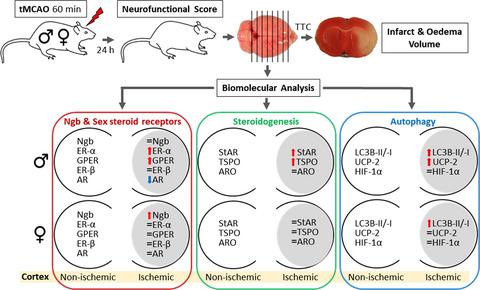当前位置:
X-MOL 学术
›
Eur. J. Neurosci.
›
论文详情
Our official English website, www.x-mol.net, welcomes your
feedback! (Note: you will need to create a separate account there.)
Insight into the molecular sex dimorphism of ischaemic stroke in rat cerebral cortex: Focus on neuroglobin, sex steroids and autophagy.
European Journal of Neuroscience ( IF 2.7 ) Pub Date : 2020-04-20 , DOI: 10.1111/ejn.14731 Estefanía Acaz-Fonseca 1, 2 , María Castelló-Ruiz 3, 4 , María C Burguete 3, 5 , Alicia Aliena-Valero 3 , Juan B Salom 3, 5 , Germán Torregrosa 3 , Luis M García-Segura 1, 2
European Journal of Neuroscience ( IF 2.7 ) Pub Date : 2020-04-20 , DOI: 10.1111/ejn.14731 Estefanía Acaz-Fonseca 1, 2 , María Castelló-Ruiz 3, 4 , María C Burguete 3, 5 , Alicia Aliena-Valero 3 , Juan B Salom 3, 5 , Germán Torregrosa 3 , Luis M García-Segura 1, 2
Affiliation

|
Including sex is of paramount importance in preclinical and clinical stroke researches, and molecular studies dealing in depth with sex differences in stroke pathophysiology are needed. To gain insight into the molecular sex dimorphism of ischaemic stroke in rat cerebral cortex, male and female adult rats were subjected to transient middle cerebral artery occlusion. The expression of neuroglobin (Ngb) and other functionally related molecules involved in sex steroid signalling (oestrogen and androgen receptors), steroidogenesis (StAR, TSPO and aromatase) and autophagic activity (LC3B‐II/LC3B‐I ratio, UCP2 and HIF‐1α) was assessed in the ipsilateral ischaemic and contralateral non‐ischaemic hemispheres. An increased expression of Ngb was detected in the injured female cerebral cortex. In contrast, increased expression of oestrogen receptor α, GPER, StAR, TSPO and UCP2, and decreased androgen receptor expression were detected in the injured male cortex. In both sexes, the ischaemic insult induced an upregulation of LC3B‐II/‐I ratio, indicative of increased autophagy. Therefore, the cerebral cortex activates both sex‐specific and common molecular responses with neuroprotective potential after ischaemia–reperfusion, which globally results in similar stroke outcome in both sexes. Nonetheless, these different potential molecular targets should be taken into account when neuroprotective drugs aiming to reduce brain damage in ischaemic stroke are investigated.
中文翻译:

洞察大鼠大脑皮层缺血性中风的分子性别二态性:关注神经球蛋白,性类固醇和自噬。
在临床中风和临床中风研究中,最重要的是要包括性别,并且需要深入研究中风病理生理中性别差异的分子研究。为了深入了解大鼠大脑皮层缺血性卒中的分子性别二态性,对成年和雌成年大鼠进行了短暂的大脑中动脉闭塞。神经球蛋白(Ngb)和其他与功能性类固醇信号传导(雌激素和雄激素受体),类固醇生成(StAR,TSPO和芳香化酶)有关的分子的表达以及自噬活性(LC3B‐II / LC3B‐I比,UCP2和HIF-1α )在同侧缺血和对侧非缺血半球中进行评估。在受伤的女性大脑皮层中检测到Ngb的表达增加。相反,雌激素受体α,GPER,在受伤的雄性皮质中检测到StAR,TSPO和UCP2以及雄激素受体表达降低。在男女中,缺血性损伤均导致LC3B-II / -I比例上调,表明自噬增加。因此,缺血-再灌注后,大脑皮层激活具有性别保护作用的性别特异性分子分子和常见分子反应,这总体上导致两性卒中的结果相似。尽管如此,在研究旨在减少缺血性中风脑损伤的神经保护药物时,应考虑这些不同的潜在分子靶标。缺血再灌注后,大脑皮层激活具有性别保护作用的性别特异性分子和常见分子反应,这总体上导致两性卒中的结果相似。尽管如此,在研究旨在减少缺血性中风脑损伤的神经保护药物时,应考虑这些不同的潜在分子靶标。缺血再灌注后,大脑皮层激活具有性别保护作用的性别特异性分子和常见分子反应,这总体上导致两性卒中的结果相似。尽管如此,在研究旨在减少缺血性中风脑损伤的神经保护药物时,应考虑这些不同的潜在分子靶标。
更新日期:2020-04-20
中文翻译:

洞察大鼠大脑皮层缺血性中风的分子性别二态性:关注神经球蛋白,性类固醇和自噬。
在临床中风和临床中风研究中,最重要的是要包括性别,并且需要深入研究中风病理生理中性别差异的分子研究。为了深入了解大鼠大脑皮层缺血性卒中的分子性别二态性,对成年和雌成年大鼠进行了短暂的大脑中动脉闭塞。神经球蛋白(Ngb)和其他与功能性类固醇信号传导(雌激素和雄激素受体),类固醇生成(StAR,TSPO和芳香化酶)有关的分子的表达以及自噬活性(LC3B‐II / LC3B‐I比,UCP2和HIF-1α )在同侧缺血和对侧非缺血半球中进行评估。在受伤的女性大脑皮层中检测到Ngb的表达增加。相反,雌激素受体α,GPER,在受伤的雄性皮质中检测到StAR,TSPO和UCP2以及雄激素受体表达降低。在男女中,缺血性损伤均导致LC3B-II / -I比例上调,表明自噬增加。因此,缺血-再灌注后,大脑皮层激活具有性别保护作用的性别特异性分子分子和常见分子反应,这总体上导致两性卒中的结果相似。尽管如此,在研究旨在减少缺血性中风脑损伤的神经保护药物时,应考虑这些不同的潜在分子靶标。缺血再灌注后,大脑皮层激活具有性别保护作用的性别特异性分子和常见分子反应,这总体上导致两性卒中的结果相似。尽管如此,在研究旨在减少缺血性中风脑损伤的神经保护药物时,应考虑这些不同的潜在分子靶标。缺血再灌注后,大脑皮层激活具有性别保护作用的性别特异性分子和常见分子反应,这总体上导致两性卒中的结果相似。尽管如此,在研究旨在减少缺血性中风脑损伤的神经保护药物时,应考虑这些不同的潜在分子靶标。











































 京公网安备 11010802027423号
京公网安备 11010802027423号